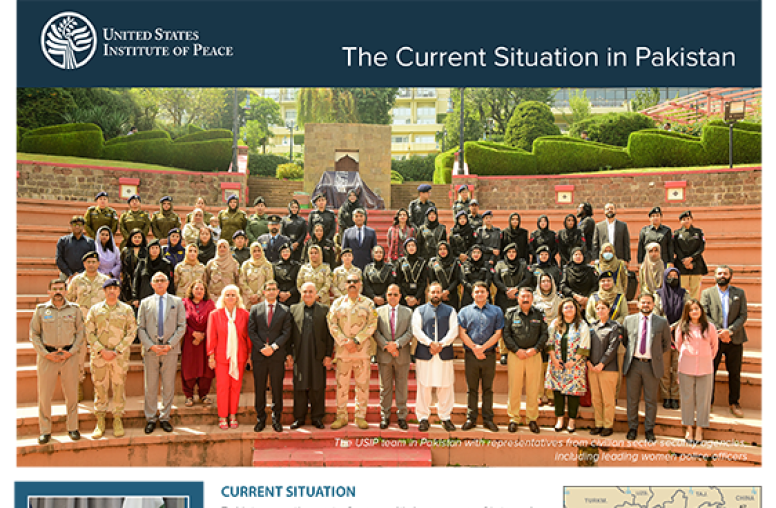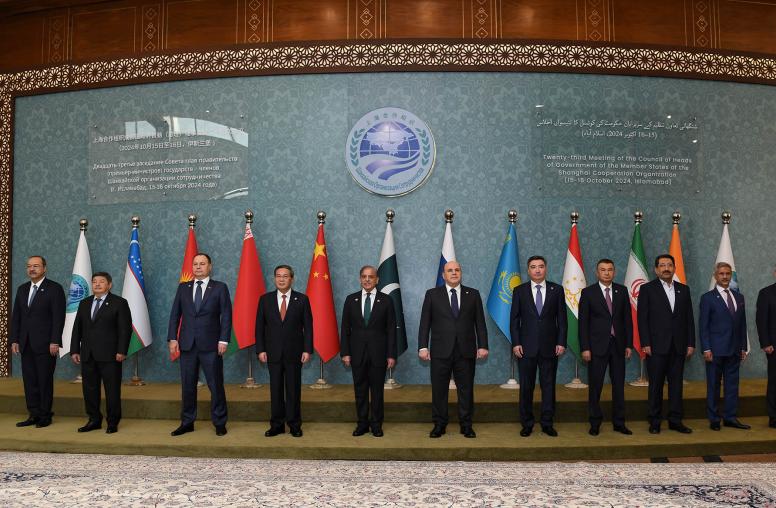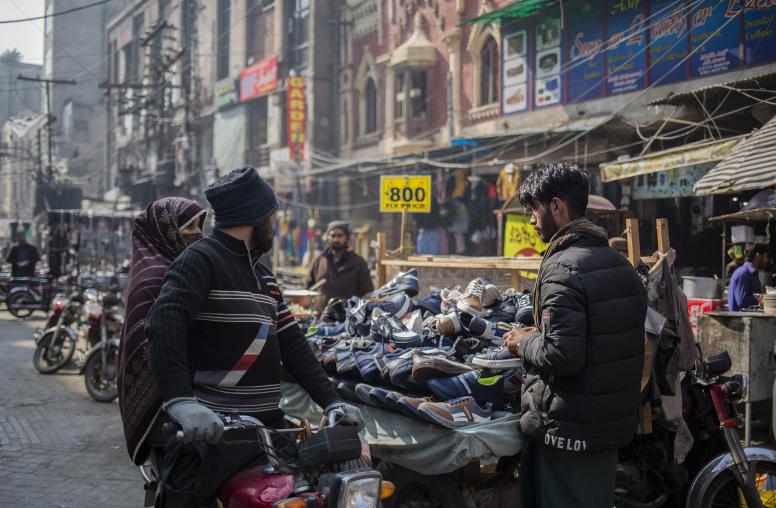Supporting Civil Society to Combat Violent Extremism in Pakistan
In the past few years, there has been an increase in funding for civil society organizations for the goal of countering violent extremism (CVE). While donors are investing large sums for CVE efforts, in Pakistan, local organizations often lack the technical capacity to understand the nature of violent extremism as well as how to utilize such large amounts of money. This brief discusses the challenges to implementing CVE programs and provides recommendations for how stakeholders can overcome these challenges.
Summary
- In the last few years, there has been an increase in funding toward civil society organizations (CSOs) for the purposes of countering violent extremism (CVE).
- Donors are pushing large sums onto organizations for CVE efforts to meet their own spending targets. However, local organizations in Pakistan lack both the understanding of what drives violent extremism and the capacity to program such large amounts of funding.
- The focus and funding on CVE have increased the pressure to produce quick results, leading to short implementation time frames and ambitious targets.
- Resources should be invested to help CSOs understand and build links with previous research done by local organizations and on a comparative basis internationally so that program interventions are aligned with current research.
- Donors should focus on refining their own internal monitoring and evaluation frameworks on CVE as well as developing a standardized index and protocols for measuring the impact of CVE programs.
Introduction
As Pakistan faces internal threats from militancy and extremism, the last few years have seen an influx of funding directed toward CSOs for the purpose of countering violent extremism (CVE). The White House Summit on Countering Violent Extremism, which convened over seventy countries in February 2015, defined CVE as “the preventative aspects of counterterrorism as well as interventions to undermine the attraction of extremist movements and ideologies that seek to promote violence.”1
Countering or preventing violent extremism requires, among other things, dismantling the extremist ideology that breeds militancy, delegitimizing groups that rely on violence to achieve their goals, introducing nonviolent forms of grievance redressal acceptable to communities, building individual resilience to social pressure to join such groups and subsequently curtailing feelings of sympathy and support for these groups within communities. These actions require a deep, nuanced understanding of local social dynamics and an understanding of how to effectively undertake these tasks in a way that is locally acceptable.
While donors have poured funds into CVE programs, they remain focused on strengthening project management and financial tracking skills rather than helping organizations transition to a new area of work that requires a specialized skill set. The capabilities of local organizations to tackle this area of work are limited, and most do not have experience with this issue. However, the international community can make a valuable contribution by: helping CSOs design programs that are in sync with existing research on CVE, aligning available funding with local capacity, and developing new tools to measure the effectiveness of CVE programs to improve future interventions.
Challenges to Developing and Implementing CVE Programs
Programs don’t reflect existing research. In Pakistan, many organizations identify poverty, lack of livelihoods, and lack of education as drivers of violent extremism, even though several research studies have negated the link between poverty and extremism.2 This thinking can be attributed in part to a lack of understanding by local organizations, as well as some donors, of the drivers of extremism. As the CVE field develops, a universal challenge will be to address the mechanics of how to disrupt and dismantle extremist groups through non-kinetic interventions. Interviews with several key informants working in the field report both a lack of fresh ideas and the presence of duplicative projects funded by different donors.3 Ideas submitted often have weak theories of change and weak links to CVE.
As a result, there is little information on what strategies are effective in either countering violent ideas, disrupting the activities of violent groups, or preventing recruitment into organizations that use violence to achieve their goals. Organizations often rely on strategies employed ten or even twenty years ago. For example, organizing marches or other mass mobilizations is a popular tool amongst advocacy groups, but little research has been done on the efficacy of this particular method or its effectiveness as a CVE tool. The changing patterns of population migration and new communication technologies render some of these older mobilization and messaging strategies more ineffectual, but they remain a popular hallmark of CVE programs being implemented in Pakistan.
Misalignment between funding and local absorptive capacity. In other cases, organizations rebrand existing programming to highlight possible (and sometimes very weak) links to countering extremism. As CVE has become the new buzzword within the donor community, with associated higher levels of funding, donors are pushing large sums onto organizations to meet their own spending targets. This push is a signal to CSOs to develop programs with large budgets that might be overly inflated but align with the greater availability of funds for CVE programming. Only a few organizations compete for donor funding in this space, making it difficult for new groups to access funding for CVE programs. As a result, more expensive models of community engagement that are not sustainable in the long term are generated.
The increased focus and funding allocations for CVE have also brought pressure to produce quick results, leading to short implementation time frames and ambitious targets. It is impossible to effectively measure lasting change in such a short period of time, thus creating incentives for false reporting and overstating program successes in order to meet donor demands. Furthermore, few local organizations have the capacity to conduct rigorous perception change assessments; most rely on weak pre- and post-test methods that do not always provide accurate results around a program’s effectiveness and medium- to long-term impact.
The Way Forward
Develop a better understanding of drivers of extremism and align program design with existing research. Most capacity building efforts are currently focused on making institutions stronger by enhancing the project and financial management capacity of CSOs. While this is an important endeavor, significant resources need to be invested in developing a CSO’s technical capacity to understand and undercut the drivers of violent extremism and the narratives of violent groups as well as develop metrics to measure the effectiveness of programs. Currently, the minimum amount of time, funding, and capacity building is dedicated to the development and refinement of ideas. One step toward helping align programs with existing research on counter-messaging or counter-recruitment is to require implementers to cite relevant research while developing their program proposals.
Investments in capacity building should focus on disseminating and helping CSOs understand and build links with previous research by local organizations and on a comparative basis internationally. There is a need to build capacity amongst CSOs to develop theories of change and program design that align with current research. Excessive reliance on programs focused on poverty and joblessness as drivers of extremism needs to be discouraged so that there isn’t an obvious schism between research and practice.
Donors should pool resources to help implementing organizations develop tools for CVE programs that have been effective elsewhere. One initiative to fill this research gap is the RESOLVE Network, which aims to develop a global network of researchers, practitioners, and policymakers focused on addressing the challenges of violent extremism. Composed of a global consortium of research, policy, and training institutes—which includes USIP—RESOLVE aims to leverage locally-informed, context-specific research on the drivers of violent extremism to improve policy and practice.4 Other models of collaboration between donor countries are the World Bank-managed Multi-Donor Trust Fund for Khyber-Pakhtunkhwa, FATA, and Baluchistan and the Global Partnership for Education.
Align available funding with local capacity. Large sums of money given to single organizations distort the local market, both in terms of employment and the cost of social mobilization and project implementation. Furthermore, very few organizations in Pakistan have the capacity to manage large sums of cash. As a result, a small group of organizations end up doing large amounts of donor-funded work that is not sustainable without this funding.
Donors should establish micro funds for CVE programs that prioritize local organizations and activists with a history of community engagement, human rights, interfaith harmony, and other CVE-related work, as well as a commitment to peacebuilding—not necessarily in an organizational capacity. USIP has developed a Peace Innovation Fund that provides micro grants to social activists who often do not have a history of working with donors and who work to develop locally relevant interventions for peacebuilding. The smaller amounts not only weed out large corporate NGOs that practice peacebuilding on a project-by-project basis but also encourage recipients to leverage local resources and links that strengthen the project. This also leads to the development of low-cost models for peacebuilding interventions that can easily be sustained through local support or scaled through other donors.
In order to reach out to groups that are not plugged into traditional NGO networks and lack proposal writing skills, donors must continually headhunt to identify these groups and invest in their ideas and systems so that they can receive, responsibly manage, and utilize donor funds. USIP regularly headhunts in Pakistan for new groups and individuals working in peacebuilding through civil society networks, academic institutions, and references from established peacebuilders.
Build more effective tools for learning from CVE programs. Donors should also focus on refining their own internal monitoring and evaluation frameworks on CVE. As previously noted, it is impossible to effectively measure lasting change within a short time period. However, if there is a need to provide quick data or gauge if programs are heading in the right direction, then donors should work to develop indicators that can be collected, reported, and analyzed quickly. Currently, data collection requirements for local NGOs are quite cumbersome and should be rationalized so that organizations are collecting relevant and essential data for analytical and reporting purposes. However, this should not be seen as a substitute for measuring the long-term impact of CVE programming, which the field requires if it is to become more effective.
Since different programs use different measures for success and perception change surveys vary across programs, there is no way to determine the effectiveness of investments made in different programs. Donors should work together to develop a standardized index and protocols for measuring the impact of CVE programs. Given that CVE programming is being funded by several international governments, it would benefit the CVE community for funders and researchers to develop common indicators, standard approaches to measuring effectiveness of programs, or an index for measuring the success of CVE interventions. These can then trickle down to implementing partners who can use them to generate more credible data for program effectiveness.
Increased coordination amongst donors working on CVE in Pakistan will be essential on matters beyond evaluations and learning. Recently the Office of Community Engagement at the U.S. Embassy in Islamabad convened a donor coordination group for organizations funding interventions for CVE. This will not only be a way for implementers and funders to network, collaborate, and avoid duplication but also an an opportunity to impart research and technical training to CSOs working in the CVE space.
Notes
- The White House, “FACT SHEET: The White House Summit on Countering Violent Extremism,” Office of the Press Secretary, February 18, 2015, www.whitehouse.gov/the-press-office/2015/02/18/fact-sheet-white-house-summit-countering-violent-extremism.
- USAID’s own development strategy challenges this still-frequent linkage; see USAID, “The Development Response to Violent Extremism and Insurgency Policy,” September 2011, www.usaid.gov/sites/default/files/documents/1870/VEI_Policy_Final.pdf. In the Pakistan-specific context, see Graeme Blair, C. Christine Fair, Neil Malhotra, and Jacob N. Shapiro, “Poverty and Support for Militant Politics: Evidence from Pakistan,” American Journal of Political Science 57, no. 1 (2013), www.sas.upenn.edu/~neilmal/poverty.pdf.
- Key informant interviews with representatives of several donor groups in Islamabad in 2015.
- www.resolvenet.org/.



